In the winter, the birds are the big focus in the bosque, but another part of nature that deserves attention are the trees. The variety here is huge, from small willows to giant cottonwoods. Some are wild (cottonwoods), some are feral (elms), some are domestic (apple). They are what makes each part of the bosque unique, and together make the environment that so many people are seeking when they move here. The winter is when many trees are being pruned, and many people are looking at all the fallen leaves in their yard and groaning. Opinions on tree care vary from leave 'em be to remove them all.
I know little about botany, but in England, trees are managed as a limited resource. I was taught conservation techniques including that saplings make great living fences (pleaching). Tall trees shed branches, die sooner and can be managed as a fuel resource (coppicing), All without needing bucket trucks, chain saws and wood masticators. Those who still farm and have orchards still remember these methods (pollarding), but as urban encroachment moves into the forests, these techniques are lost in favor of fast results and bankable assets such as clean lawns and open vistas.Many insects and plants think it is Spring. This little plant is sprouting through the concrete lining of a stabilized arroyo.
This insect is a seed bug. They are not supposed to be out, but the warm temperatures have them crawling around.This wasp is checking out our house looking for a new site for nesting. Competition can be fierce (here are already several established paper wasp nests in the area).
This moth is actually playing dead, but it is too cold to fly away quickly. Insects are definitely slower in the lower temperatures. Moths are able to be active longer by using the cracks in walls for warmth. The air under the leaves is warmer than the air at night and they use this as a resting place too, as well as laying eggs for the next generation. Moths are vital to the animals during winter as they have large stores of fat under that "fur".
This mature cottonwood is competing for light by growing tall, with few lateral branches.
those shallow roots and thin trunks are at high risk for breaking apart.these younger cottowoods show the competition they face from the faster growing, but shorter willows close to the river banks where the real estate is more variable due to flooding.By the river bank, the closely growing willows usually crowd out other trees until modifiers like beavers, people, or flooding open up new areas.Other trees have different strategies. Olive trees put out bushy, short branches to clear a space and then grow upwards. they are more tolerate of shaded areas but will end up dominating an area later.Trees change their growth strategy depending on where they are. So you can cut the top branches short and the tree will put out many smaller branches vertically to maximize chances of future growth in favorable directions.














No comments:
Post a Comment